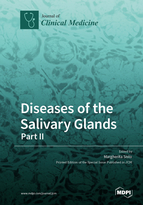Diseases of the Salivary Glands—Part II
A special issue of Journal of Clinical Medicine (ISSN 2077-0383). This special issue belongs to the section "Otolaryngology".
Deadline for manuscript submissions: closed (25 July 2022) | Viewed by 24623
Special Issue Editor
Interests: pathophysiology and molecular immunology applied to immunological research lines; molecular processes underlying the interaction between receptors of the immune response, inflammation and characterization of new anti-inflammatory molecules; novel therapies for Sjögren’s syndrome autoimmune disease; evaluation of the molecular mechanisms linking chronic inflammation to fibrosis in Sjögren’s syndrome and others autoimmune diseases
Special Issues, Collections and Topics in MDPI journals
Special Issue Information
The year 2021 saw the publication of the Special Issue “"Diseases of the Salivary Glands" (https://0-www-mdpi-com.brum.beds.ac.uk/journal/jcm/special_issues/Salivary_Glands), Part I, covering recent and novel advancements as well as future trends in the field of research evaluating diagnostic and therapeutic treatment of salivary gland (SGs) diseases. Part I includes manuscripts focusing on the most advanced diagnostic techniques for the identification of pathologies affecting the SGs, the molecular mechanisms involved in the autoimmune disease Sjӧgren’s syndrome, SGs tumor diagnosis and treatment, and interesting case reports related to primary or secondary diseases of SGs. Local management with novel therapies and pilot studies in emerging fields was covered, too. The Special Issue, Part I, provides important insight into the diagnosis, pathogenesis, natural history, and management of SG diseases, including 14 articles, written by an impressive group of internationally recognized authorities in the field, comprising both researchers and clinicians.
Given the enormous success of Part I, the Special Issue “Diseases of the Salivary Glands” Part II has been launched, with the firm belief that it will enrich the panorama of world research in this field.
Topics include:
1) Clinical features and presentation of potentially malignant SG disorders;
2) Risk factors and etiopathogenesis of SGs tumors;
3) Etiopathogenesis and molecular mechanisms involved in the chronic inflammatory condition characterizing Sjӧgren’s syndrome;
4) New discoveries in the field of micro RNAs associated with Sjӧgren’s syndrome;
5) Molecular markers linked to development and progression of SG diseases: current knowledge and future implications;
6) More innovative techniques for the study of the SG diseases: current limitations and future directions.
Submissions are welcome, both solicited and unsolicited, which will contribute to this goal.
Prof. Dr. Margherita Sisto
Guest Editor
Manuscript Submission Information
Manuscripts should be submitted online at www.mdpi.com by registering and logging in to this website. Once you are registered, click here to go to the submission form. Manuscripts can be submitted until the deadline. All submissions that pass pre-check are peer-reviewed. Accepted papers will be published continuously in the journal (as soon as accepted) and will be listed together on the special issue website. Research articles, review articles as well as short communications are invited. For planned papers, a title and short abstract (about 100 words) can be sent to the Editorial Office for announcement on this website.
Submitted manuscripts should not have been published previously, nor be under consideration for publication elsewhere (except conference proceedings papers). All manuscripts are thoroughly refereed through a single-blind peer-review process. A guide for authors and other relevant information for submission of manuscripts is available on the Instructions for Authors page. Journal of Clinical Medicine is an international peer-reviewed open access semimonthly journal published by MDPI.
Please visit the Instructions for Authors page before submitting a manuscript. The Article Processing Charge (APC) for publication in this open access journal is 2600 CHF (Swiss Francs). Submitted papers should be well formatted and use good English. Authors may use MDPI's English editing service prior to publication or during author revisions.
Keywords
- oral medicine
- oral disease
- salivary gland dysfunction
- potentially malignant oral disorders
- cellular and molecular pathway
- autoimmune diseases







